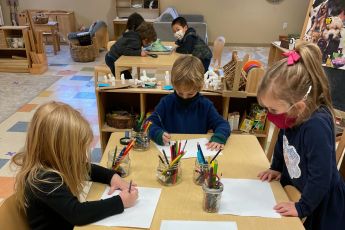Since the pandemic began, 40 percent of U.S. child care programs have temporarily or permanently closed their doors. Stringent public health guidance has limited class sizes and staffing, and new health and safety protocols created new costs. Between reduced enrollment and increased spending, many child care operators are in perilous circumstances, and that instability ripples outward to the parents who rely on care, to the workplaces who rely on parents, and so on.
“The need for child care that supports working and student families has never been more visible,” says Phyllis Stewart Pires of the Stanford WorkLife Office. “Every community and every area of the workforce continues to feel it.”
Stewart Pires and her team oversee Stanford’s onsite child care system, one of the largest in higher education, by collaborating with the operators and educators who run them. Throughout the past year, they have worked closely with university leadership to identify ways to support child care at Stanford, to keep the lights on and continue to serve hundreds of university families.
Continually adjusting to operational challenges
Early in the shelter-in-place period, one center was dedicated to first responders and medical professionals on the frontline of patient care. As researchers returned to campus, classrooms reopened to accommodate them. As faculty prepared for a virtual fall quarter and staff in various support positions returned to campus, the center’s enrollment grew as the state’s guidelines would allow. Today, five of the six centers are open to nearly 400 children who spend each day engaged in stimulating learning activity and play with their friends.
As the situation unfolded, leadership confronted the financial instability where it could.
In addition to providing pay continuation to teachers, the university helped mitigate the financial losses caused by reduced tuition revenue and increased labor costs, and covered the cost of deferring the FY21 tuition increase to families. Stanford supports weekly testing for teachers and other health and safety measures, which allows the centers to remain open and plan for a day when restrictions are lifted.
Teachers maintain the sense of community
While the university and Worklife Office worked with operators to address administrative needs, the educators combated another hurdle: parents hesitancy to return to a group care setting. They worked to grow comfort and confidence through socializing the new health and safety protocols, increasing communication, designing creative processes to support children through the adjustments, and building community despite the absence of typical family events. And they are proud of what they’ve achieved so far.
“These past months have surely been filled with many changes, and with that, we’ve demonstrated the openness and flexibility that comes along with being a committed educator who serves to benefit the lives of children and the community,” says Katrina Rey, teacher at Madera Grove Children’s Center.
“Child care educators have become essential to the fabric of our community”, adds Nathalie Larsen, administrator at Pine Cone Children’s Center. “I have felt privileged to provide rich programs for children during this time, adapting procedures to operate safely and renewing our focus on relationships and the social well-being of children and adults,” she says.
There is a great appreciation for the child care community and their service on the frontline so that parents can focus on their work demands during an incredibly challenging time.
“Thank you all for being so amazing, responsible and caring,” shares Anca Pasca, a parent at Stock Farm Road Children’s Center. “We know you all took risks to be there, but you saved our family during these really hard times and we couldn’t be more grateful.”
What our children can teach us about being resilient

Children in Stanford’s onsite child care centers have shown incredible resiliency, their teachers say, in the face of new routines during the pandemic. (Image credit: Photo courtesy of the WorkLife Office)
For the children, returning to the classroom starts with a daily health check, and for those two or older, a reminder about how to wear their face-covering. Teachers have transformed their outdoor environment to accommodate the longer hours children spend outside. Teachers worried about the children’s response to teachers in face coverings and how language development might be affected, and to the new routines and restrictions, but they say they have witnessed children being very resilient through all of these changes. “Our youngest children look at our eyes and still see and recognize how we are feeling,” says Emily Reyes, Children’s Center of the Stanford Community teacher. “They smile back at adults who are smiling through their masks. Everyone is wearing a mask so it’s not as scary for them as we feared.”
As the teachers report it being a challenging time, they feel buoyed by the support of their management teams, the gratitude of the parents and the joy that comes from engaging with children. They also express feelings of encouragement, a stronger sense of community and respect for their colleagues. The pandemic has inspired them to rise up, stay open to change and be creative in support of the community they serve.
“After the first few weeks of the pandemic, I found it was easier to focus on the type of teacher I needed to be, more flexible, more determined, more creative,” says Yolanda Henry, teacher at Madera Grove.
“Many programs across the nation do not have strong support systems like ours,” adds Stewart Pires. “We are grateful for the well-supported system we have at Stanford.”
For more information about Stanford’s child care centers and resources available during the pandemic, visit the COVID-19 Family Resources page.